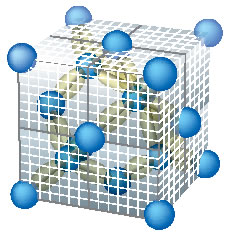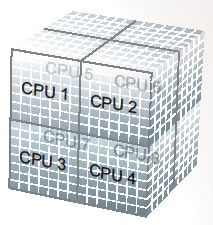Interview with RSDFT Developer Junichi Iwata
|
Subject
|
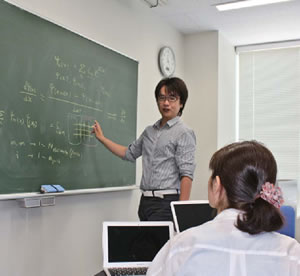 |
RSDFT stands for the "Real-Space Density-Functional Theory" calculation method. It is an application for performing first-principles calculations of various material properties without depending on empirical adjustment parameters. RSDFT is an attempt to conduct first-principles calculations on a scale of 100,000 atoms using the K Computer. We talked to Junichi Iwata of the University of Tokyo, the person who has been the driving force behind the development project, to ask what "first-principles calculations" are and the distinguishing characteristics of RSDFT.
What are First-principles Calculations?
Various materials are present around us. Their properties, such as color and hardness, are many and varied. How are these properties determined? Condensed matter physics researchers investigate the behavior of electrons and atomic nuclei in order to understand the nature (physical properties) of materials. In such microscopic level, however, it is difficult to understand all of the behavior of electrons and nuclei through experimentation alone. For this reason, numerical calculations or numerical experiments play an important role. First-principles calculation is a method of performing such the crucial role. “First principle” means “the most basic principles, ones that cannot be deduced from other principles or hypotheses and so on.” The term is also used in philosophy and other disciplines in addition to physics. Dr. Iwata made clear that there are subtle differences in what is meant by “first principles” depending on the field of research.
“In condensed matter physics, ‘first principles’ refers to the fundamental laws of quantum mechanics. Calculations that use these fundamental laws as a starting point and include no empirical parameters, except the fundamental physical constants such as electron mass and charge , for the purposes of adjustment with experimental results, are referred to as first-principles calculations. The ultimate goal of condensed matter physics is to predict the properties of all of the materials that may exist in the world, based on the first principles of quantum mechanics. However, it is practically impossible to perform all calculations starting from the first principles without any approximation. Depending on the target of researches and the scale of the system being considered, the fundamental equation must be transformed into more sophisticated one suitable for practical calculations, and approximation must be applied to get results with required accuracy as fast as possible.”
Even calculations that are generally referred to as first-principles calculations t h e basic equation and the degree of approximation. The Real- Space Density-Functional Theory (RSDFT) that Dr. Iwata has been developing is a program for performing first-principles calculations in quantum mechanics for systems with many electrons and atomic nuclei, based on the density-functional theory that was awarded the Nobel Prize for chemistry in 1998. First-principles calculations predict physical properties more reliable than methods in which empirical parameters are introduced. However, the first-principles calculations are disadvantageous in that they are only capable of handling a small number of atoms (it is said that they can handle at most several hundred to a thousand atoms). Dr. Iwata says that RSDFT makes it possible to perform calculations for systems consisting of 100,000 atoms.
|
Fig.1 Discretization and parallelization for the purpose of conducting real-space calculations Silicon crystal unit cells |
|
|---|---|
|
|
|
| Electrons (yellow) are present in a continuous distribution around silicon atomic nuclei (blue) arranged in a space. In the real-space method, this continuous electron density distribution is depicted as points on a discrete mesh. | The real-space mesh is divided into large blocks. A different CPU handles each block, and adjacent CPUs communicate with one another and execute calculations in a coordinated manner. |
What is a Program RSDFT?
In order to determine physical properties, it is crucially important to calculate the electron states. To examine the materials around us, it is sufficient to consider only systems made up of valence electrons (outer electrons) and ions (aggregates of core electrons and atomic nuclei). RSDFT uses the density-functional theory to calculate valence-electron states. Density-functional theory can calculate the energy ground state of electrons (expressed as a wave function) using only the density distribution of electrons. As these calculations are simpler than solving the Schrödinger equation, they are suitable for solving many-electron systems. “RSDFT is designed to solve the Kohn-Sham equation, the fundamental equation in density-functional theory, in the most efficient manner possible on supercomputers,” says Dr. Iwata. RSDFT is characterized by the approach that the Kohn-Sham equation, which is a partial differential equation mathematically, are solved as a finite-difference equation numerically.
In the first-principles calculations for up to several hundred atoms that have been performed up to now, great success has been achieved with calculation techniques that express wave functions as superposition of simple plane-wave basis and use fast Fourier transformation (FFT). However, as computers become larger in size and massively parallel in nature, FFT requires enormous amounts Computational Materials Science Initiative of communication time, and as a result this has become a bottleneck for massively parallel computing. But with RSDFT, Dr. Iwata has developed a technique for calculating wave functions using the real-space method, which in theory was known to be able to draw out sufficient performance from parallel computers. In the real-space method, the space is represented as a discrete three-dimensional mesh, and numerical calculations are performed to determine wave function values at each point on that mesh. Moreover, the mesh space is divided into several blocks, and each block is calculated by different CPUs. In other words, the actual space that has been divided into blocks is mapped onto the computer that has been divided into compute nodes in the same manner ( F i g . 1). This allows the work to be allocated in an efficient manner and enables parallel computing with little waste. The calculation of wave functions with the real-space method eliminates the need to use FFT, thereby resolving the communication problem.
| Fig.2 Structural changes in transistors as a result of miniaturization | Fig.3 Atomistic model of a silicon nanowire (section diameter: 5 nanometers) |
|---|---|
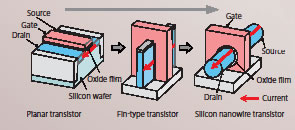 |
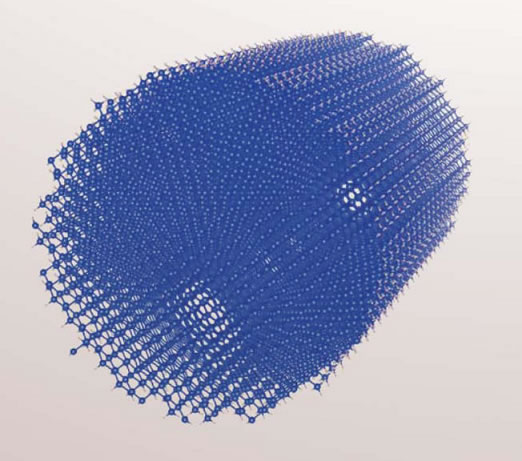 |
Interchange with Computer Scientists Resulted in Dramatic Progress
RSDFT has another advantage with respect to increasing calculation efficiency: the Gram-Schmidt orthogonalization algorithm. Orthogonalization of wave functions is an indispensable calculation. However, the computational cost of the orthogonalization is proportional to the third power the system size, and therefore the simulation of large physical systems resulted in an explosive increase of the computational time. “The problem was solved by replacing the algorithm based on the inner product of vectors with an algorithm based on the matrix product, which can be computed highly efficiently” says Dr. Iwata. Borrowing the wisdom of computer science made it possible to dramatically increase calculation efficiency.
The development of RSDFT was a continuation of the PACS-CS (Parallel Array Computer System for Computational Sciences) development project at the University of Tsukuba. At monthly joint meetings with computer science researchers, Dr. Iwata explained what he wanted to accomplish with RSDFT. “I explained many times what I wanted to do, and they gave me various kinds of advice,” recalls Dr. Iwata. “ Initially I found it is difficult to understand the computer science jargon, but after repeating the face-to-face meetings several times, we became to be able to talk smoothly without any problems. In addition to the Gram-Schmidt algorithm, I was able to learn the latest theories in computer science, outside of my expertise. That was also helpful for developing the program . ” Close communication with computer science researchers appears to have been the key of the success. At the same time, the one-to two-year period during which Dr. Iwata was focused on developing RSDFT was also a frustrating time for him. Dr. Iwata’s main duty is physics research. Because so much of his time was taken up with software development, he was unable to do the work that he should do as a researcher, producing data and publishing the achievements in the form of academic papers. While he was working to develop RSDFT, he battled uncertainty with regard to whether or not he was doing the right thing. How did he keep up his motivation ? “ I knew that when I completed, I’d be able to calculate anything. I believed that it would surely have a major impact. And I’ m a person with a great deal of patience.” Dr. Iwata’s inherent tenacity enabled him to get through the periods in which no achievements were produced. However, currently in Japan it appears that researchers are not held in high regard for developing software alone. “Someday I’ d like to change that,” says Dr. Iwata, aware of his position as a member of the CMSI project.
Application to Next-generation Semiconductor Device
The K Computer makes it possible to execute first-principles calculations on the scale of several tens of thousands to 100,000 atoms. What can be studied? In their simulations of 100,000 atoms, Dr. Iwata and his colleagues are targeting semiconductor devices. Semiconductor devices are an indispensable part of the PCs, cell phones and other electronic devices that we use in our daily lives. Miniaturization of these devices has been pursued in order to reduce power consumption and achieve faster speeds. When a device has been reduced down to the size of several nanometers, however, the quantum mechanics behavior of the electrons comes to have a direct impact on performance, and it is difficult to establish a detailed design approach to such devices through experimentation alone. For this reason, there are great expectations for first principle computing. The field-effect transistors that have been used in semiconductor devices have a structure in which an oxide film and a metal object called a gate are placed on top of a flat silicon wafer. The voltage of the gate electrode is turned on and off to control whether or not the current flows in the silicon, making the device function s a switch. However, if the device is made too small (on the level of several anometers), there is a tiny bit of current eakage even when the current flow is off, nd therefore transistors are nearing the oint at which miniaturization is no longer easible. For this reason, nanowire ransistors with cylindrical or square column shapes rather than the onventional two-dimensional laminated tructure have been proposed as the next eneration of semiconductor devices. Nanowire transistors will have a structure n which the oxide film and gate metal nclose a wire made of silicon (silicon nanowire ) ( Fig. 2 ) . In actual silicon anowire transistors, the cross-sectional diameter is expected to be 1 0 - 2 0 anometers, and the distance that current will flow is expected to be 5-10 anometers (Fig.3). The transistor will be made from 100,000 silicon atoms, that is xactly the size which can be calculated using the K Computer. Dr. Iwata speaks enthusiastically about these devices, saying “I want to perform calculations on the K Computer to clarify the physical properties of nanowire transistors in order to develop these transistors for actual use.” Besides semiconductor devices, biomolecules also have been focused as another target of RSDFT. The use of RSDFT will enable simulation of a entire molecule in the case of a simple protein. Since RSDFT can be applied not only to solids but to liquids and gases as well, it is expected to have applications for a wide variety of materials.
Research assistance provided by Shinya Kyogoku (Graduate School of Engineering, the University of Tokyo) Pictures provided by Kuniyuki Kakushima (Tokyo Institute of Technology)
【Number One in the World for Software, Too?】
In June 2011, we received some wonderful news. At the 26th International Supercomputing Conference (ISC'11 - see pg.15), the K Computer was ranked number one in the world in the Top 500 ranking of computer processing performance for its world's highest performance of 8.162 petaflops. This November, the winner of the IEEE Gordon Bell Prize, the world's highest award for software development, will be announced. The IEEE Gordon Bell Prize has been called the Nobel Prize of the supercomputer world, and it is awarded for breakthroughs in parallel computing during the year. RSDFT has been nominated for this prize and is currently a finalist. We hope the outcome brings recognition as world number one in the area of software as well.
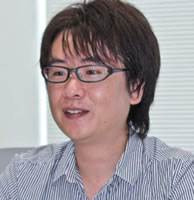 |
Junichi Iwata Studied techniques for programming electric circuits and the like in his student days, but became interested in physics (especially quantum mechanics) in the course of pursuing independent study to substantiate calculation techniques. In graduate school, went on to work in a nuclear theory laboratory, and was awarded his Ph.D for research into the optical response of electron systems using the time-dependent densityfunctional method. Began research into parallel computing in 2005. Also began teaching computer science as a CMSI lecturer in August 2011. Interests include eating ramen, playing mah-jongg and jumping. |
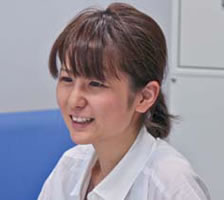 |
Yoshimi Kubota ◆ Interviewer's Postscript |

